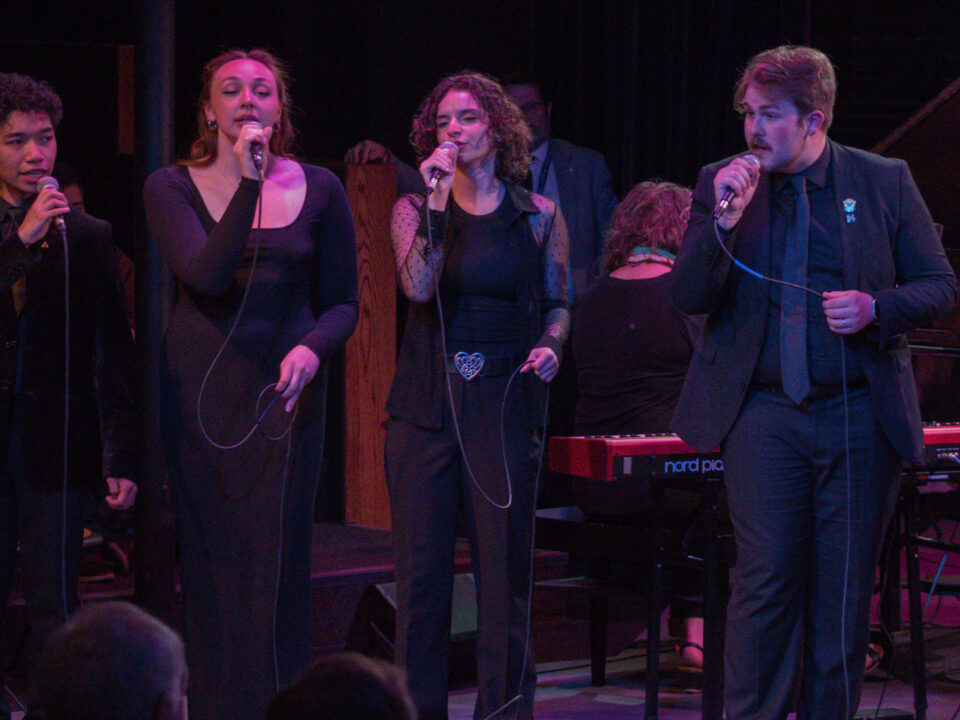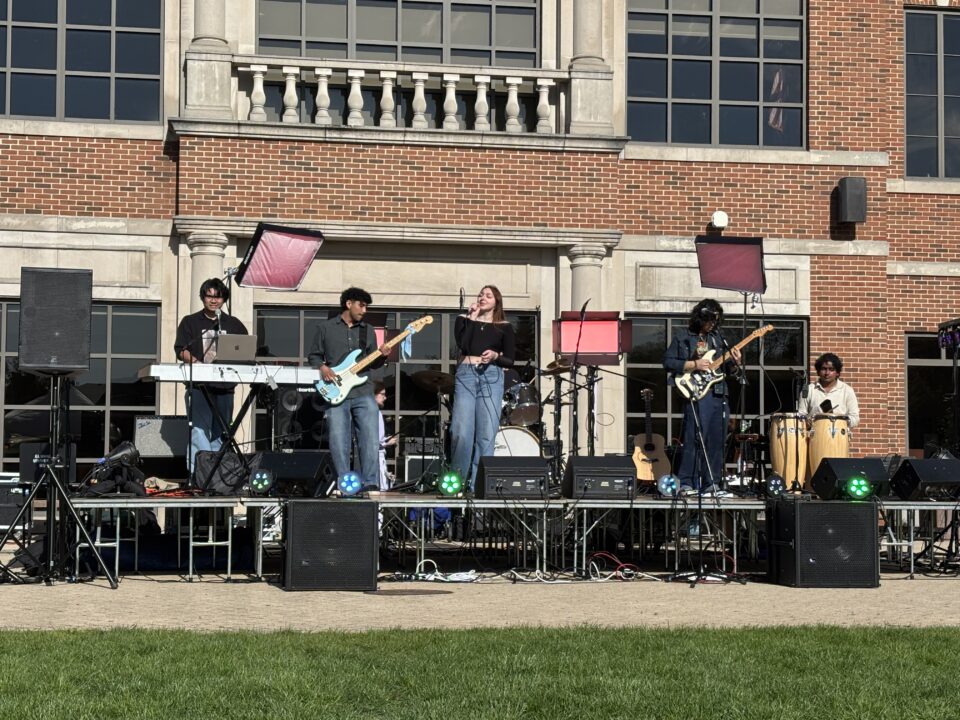Yoga Going Beyond Providing Flexibility and Strength

The room is dimly lit, casting soft shadows over the seven beds laid out on the floor, where participants of the “new moon” sound healing event lie snuggled underneath their blankets, eyes closed, ears open, absorbing the sounds.
“New moons are always a time of dreamy energy, but also intuitive energy. So tonight as I play, let this time be for deep reflection, for setting your intentions, for embracing the flow of the unknown, releasing expectations, releasing old fears, stepping into this new chapter, into the spring with faith.”
Jenny Bergold instructs her class to notice how they feel as she begins to play shimmering bells and deep-humming beats on the drums.
Following the COVID-19 pandemic, several forms of yoga such as hot yoga or vinyasa have stepped to the forefront as tools for addressing mental health concerns like depression, anxiety, and stress. Yoga, combined with sound healing, breath work, and meditation, has gained popularity to promote overall well-being and mindfulness, offering participants a way to overcome day-to-day struggles and relax.
Bergold has been teaching yoga for almost 17 years and has incorporated sound into her classes for 15 years. She highlights working with mind, body, and spirit for her students. To connect these elements in her classes, Bergold builds in readings for students to focus on. During the class, students are instructed to set intentions to meditate on and focus on deep breathing.
“I started this because I had PTSD, depression, and anxiety, so because yoga saved my life how many years ago, I want that to be for other people,” said Bergold.
Bergold first began working in downtown Chicago at Channel 11 WTTW as a producer for documentaries and kids’ television. During her time in production, she began to have panic attacks. 20-hour days and sleeping in edit suites came with the demands of the job of production, but the stress led Bergold to go to the doctor about her panic attacks.
“My doctor literally wrote on a prescription pad, ‘go to yoga three times a week and meditate every day.’ So I found my first class down at the community center down here in Batavia, and that’s how I got involved,” said Bergold
The practice of yoga is not a new concept, its origins date back over 5,000 years. According to the National Center for Health Statistics, yoga practice utilized by US adults over the age of 18 rose from 9.5% in 2012 to 14.3% in 2017.
Yoga’s elements lie in connecting mind, body, and spirit, breathing, and meditation. These elements are often remedies for combating mental health issues.
Stress, depression, and anxiety are just a few of the mental health issues that people face daily. These mental health issues are often referred to as common mental health disorders or any mental illnesses. (AMI) According to the National Institute of Mental Health, in 2018, approximately 8.9 million young adults aged 18 to 25 (26.3%) had AMI in that year. In 2022, the percentage of young adults aged 18 to 25 with AMI in that year was approximately 12.6 million people (36.2%).
Mental health issues such as depression can be genetic or can occur from triggering events such as job loss, sudden death, or dramatic change such as the COVID-19 pandemic.
Through the practice of mindfulness, yoga reduces stress and anxiety, improves mood, and reduces depression.
Co-owner of Illuminate Therapy and Wellness and licensed clinical professional counselor Greta Nielsen incorporates mindfulness and the importance of being connected to mind, body, and soul to her patients.
When feeling dysregulated or unable to regulate emotions, Nielsen assists her patients in focusing on their five senses. Through this exercise, patients are asked what they see, then going on to what they hear, what they feel, not emotionally but physically, then do they taste anything, do they smell anything. Through this practice it allows participants to focus on one thought at a time and attune to that thought.
Nielsen also incorporates letting-go exercises. Through this Nielsen encourages patients to recognize that the brain is always working and is rarely void of thought but being able to say; “is that the thought that I want to tend to is that a thought that doesn’t serve me right now?”
Through these exercises, Nielsens is teaching groundedness, the state of emotional and mental stability to her patients.
“Mindfulness has a lot of grounding and relaxation to it, so we are working on regulating the nervous system through breathing and grounding exercises just to be able to keep the whole body as calm as possible because if our body is calm, our mind is going to be calm,” said Nielsen.
Denise Klibanow, Licensed Clinical Professional Counselor incorporates elements of breath & bodywork, mindfulness, and dance movement therapy into her sessions and focuses on the mind-body and spirit connection.
Integrating these three elements, she keeps the goal of removing the mind-body split that many people have.
“In Western civilization, we see people say ‘I wish my body would do this, I wish my body didn’t do this’. Helping people to reintegrate into your body is about using breath and movement and recognizing that we are a whole being. I think we are now moving toward recognizing the mind, body, and spirit more. A lot of my work is about integrating and helping people to recognize those connections,” said Klibanow.
Body-based processes such as breathing stem from regulation, which is based on rhythmic movement.
“You can’t communicate with someone who is dysregulated, so when we can get people back into their bodies and grounded and center, this starts with basic breath work, or rhythmic movements like rocking, clapping, or tapping. This taps into the parasympathetic network and helps people regulate better,” Klibanow said.
There are several forms of yoga that people practice, incorporating mindfulness, regulation, groundedness, and breathing into their lives.
Hot yoga or Bikram yoga is performed in a heated room set to around 80-100 degrees and can include a variety of poses and breathing exercises while incorporating physical exercise. Despite the hot temperature of the room this form of yoga can reduce stress levels and ease stress.
In a study conducted by the San Francisco Veterans Affairs Medical Center in 2017, 23 male veterans participated in twice-weekly yoga classes for eight weeks. All participants said they would recommend the program to other veterans, and it was found that participants with elevated depression scores before the yoga program had a significant reduction in depression symptoms after the eight weeks were completed.
Bergold is certified in nine different forms of yoga, but her main focus has been yin and yang yoga, which incorporates both deep gentle stretching, restorative or supportive yoga and deep meditation.
“Everyone is different, bodies are different, and everyone needs different things to work through what they are going through, and that’s why I focus on sound healing and yin and yang yoga. When people are anxious or burned out, they need something to calm them down, so breathwork is an important practice that helps people with anxiety. People need to relax, learn to slow down, and honor their bodies and emotions.” Bergold said.
Bergold believes in dealing with reality, facing and honoring emotions, she embodies this through deep shadow work in her classes which is a process of confronting emotions and repressing parts of yourself.
For people hesitant about taking yoga and practicing mindfulness Bergold believes that potential participants must be open to yoga and mindfulness before it can make a difference in their lives.
“Once someone is open to taking yoga and practicing mindfulness then it will work for them but they have to discover it first because someone has to be interested in it or seeking it out before anything else because yes people are dealing with these issues, but you have to find what works for you,” Bergold said.
Bergold continues to host pop-up events in the suburbs of Illinois and teach classes at the Newton House in Batavia. She conducts almost 15 sound healings a week and writes poems during each session to channel messages that come through–giving these messages to her students as a form of love, hope, and faith.


